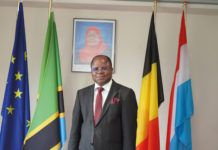As world leaders make plans to recover from the impact of Covid-19 on their respective economies, Namibia, like others, has labored, tirelessly to craft a plan for its economic recovery. Knowing this will be another challenging year in this regard, His Excellency the President of the Republic of Namibia, Dr. Hage Geingob declared the year 2021 the year of resilience. This set in motion the crafting of a recovery plan so ambitious, it leverages the country’s natural resources to the fullest.
Many have wondered whether this plan is not too ambitious? Some have questioned the country’s readiness or ability to execute such a daring plan. Others have questioned whether the country has the requisite skills set to pull this off. Despite the odds, Namibia has chosen to stand resolute. Where many would have pulled back and succumbed to the pressure of “new beginnings” and the criticism of the nay-sayers, Namibia has chosen the risk of the path less travelled, going after this audacious dream.
This dream is known as Namibia’s Southern Corridor Development Initiative (SCDI). This is an accelerated sustainable and resilient climate focused initiative that supports the Paris Agreement Goals. It consists of a portfolio of complementary projects and infrastructure in the south of Namibia that will maximise the investment opportunities provided by Green Hydrogen and Ammonia, for the country.
This initiative is derived from Namibia’s Harambee Prosperity Plan II, and will open new opportunities for Namibia, positioning Namibia strategically ahead of her peers in many sectors. The SCDI is developing a Green Hydrogen project powered by nature, using wind and solar resources, and will create further opportunities in spin off sectors of

Agriculture;
Logistics;
Energy; and
Mining.
|
Project |
||
|
Agriculture |
3100 Ha of Green Farms |
This project is aimed at increasing domestic food production and reducing dependence on imports so as to ensure food security in Namibia. |
|
Renewable Energy |
220 MW Energy Portfolio |
By 2025 Namibia will achieve a target power installation capacity of 879 MW by the end of the HPPII period. |
|
Logistics: Rail |
Green Sandverhaar Rail |
This project looks to support transportation of manganese from the Northern Cape to the Port of Luderitz, thereby further increasing trade between RSA and Namibia. |
|
Logistics: Port |
Green Luderitz Port |
Develop an entirely new deep water port in the adjacent bay at a location called Angra point. With Green Hydrogen production in the south. This port will be used to transport GH2, manganese, crops (dates and grapes) and zinc. Through this initiative, Namibia is poised to produce the first green zinc through the SCDI. |
(Above a table of the different projects and how they will impact Namibia)
The above projects will not only address the creation of new industries, create employment and grow the economy, but will also create avenues for Namibia to address other socio-economic challenges, such as hunger, inequality and poverty. The initiative will provide opportunities to create value-added industries such as the production of fertilisers and other related by-products. Not only that, the initiative allows for the creation of Special Economic Zones to promote the
development of new industry and manufacturing of products needed for the realisation of the dream e.g. manufacturing wind turbines and other related products.
The Green Hydrogen industry has engineered opportunities of other off-shoot industries which would otherwise never have been initiated to find expression under the ambit of the SCDI. Through one initiative, Namibia is leveraging the potential in a single industry to unlock a myriad of sectoral benefits, creating gainful and quality employment, and developing much needed skill sets among Namibians.
This initiative will further generate new and diversified frontiers of growth, by optimising
the stewardship of our natural resources and public assets, while proactively pursuing opportunities in the blue and green economies.
The audacity of assuming such a project is estimated to cost the Namibian government more than 200 billion Namibian Dollars. Funding will be sourced by way of developing innovative financing tools such as:
1) Central Security deposit;
2) Integrated National Financing Framework;
3) Sustainability Bond, and;
4) Multi-listing.
Namibia recognises the need to engage potential investors at all possible levels, and with initiatives such as implementation of the SCDI, Namibia has clearly communicated a message that we are here and are ready for business.
For more information on the Southern Corridor Development Initiative, please visit www.gh2namibia.com or contact the Namibia Investment Promotion and Development Board (NIPDB) by sending an e-mail to info@nipdb.com.
![[:en]view-of-luderitz-in-namibia-2021-08-26-15-34-25-utc[:]](https://perspectives-cblacp.eu/wp-content/uploads/2022/01/view-of-luderitz-in-namibia-2021-08-26-15-34-25-utc-696x462.jpg)


